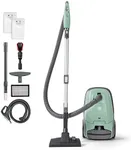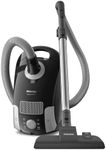Buying Guide for the Best Bagged Vacuums
Choosing the right bagged vacuum cleaner can make cleaning your home much easier and more effective. Bagged vacuums are known for their hygienic dust disposal and consistent suction, but there are several features to consider to ensure you get the best fit for your needs. Think about the size of your home, the types of floors you have, whether you have pets, and any allergies in your household. Understanding the key specifications will help you make a confident and informed decision.Bag CapacityBag capacity refers to how much dust and debris the vacuum bag can hold before it needs to be replaced. This is important because a larger bag means you can clean more before having to change it, which is convenient for bigger homes or frequent cleaning. Small capacity bags (under 2 liters) are suitable for apartments or light cleaning, medium (2-4 liters) works well for average-sized homes, and large (over 4 liters) is best for big houses or heavy-duty use. If you clean often or have a large space, a bigger bag will save you time and effort.
Filtration SystemThe filtration system determines how well the vacuum traps dust, allergens, and tiny particles. This is especially important for people with allergies or asthma. Basic filters capture larger particles, while HEPA filters can trap very fine dust and allergens. If you or your family members have sensitivities, look for a vacuum with a HEPA or similar high-efficiency filter. For general cleaning, a standard filter may be enough, but for allergy control, advanced filtration is a must.
Suction PowerSuction power measures how effectively the vacuum can pick up dirt from floors and carpets. Stronger suction is better for deep cleaning, especially on thick carpets or if you have pets. Lower suction is usually fine for hard floors or light messes. Vacuums often list suction in watts or air watts; higher numbers mean more power. If you have mostly carpets or pets, choose a model with higher suction. For mostly hard floors or light cleaning, moderate suction will do the job.
Weight and ManeuverabilityWeight and maneuverability affect how easy the vacuum is to use, especially if you need to carry it up stairs or move it around furniture. Lightweight vacuums (under 10 pounds) are easier to handle and best for people who want something simple to move. Heavier models may offer more power but can be harder to carry. If you have multiple floors or limited strength, a lighter vacuum is a better choice. For single-level homes or if you don’t mind the weight, a heavier model may be fine.
Noise LevelNoise level is how loud the vacuum is when in use, usually measured in decibels (dB). Quieter vacuums are more comfortable to use, especially in apartments or if you clean while others are home. Low-noise models are typically under 70 dB, while standard vacuums can be louder. If you’re sensitive to noise or have young children or pets, look for a quieter vacuum. If noise isn’t a concern, this may not be a top priority.
Included AttachmentsAttachments are extra tools that come with the vacuum, like crevice tools, upholstery brushes, or pet hair tools. These can make cleaning different surfaces easier and more effective. If you have pets, look for a vacuum with a pet hair tool. For cleaning furniture or tight spaces, attachments like crevice tools and dusting brushes are helpful. Think about the surfaces and areas you need to clean most often and choose a vacuum with the right attachments for those tasks.
Cord LengthCord length determines how far you can move from the power outlet without unplugging the vacuum. Longer cords (over 25 feet) are useful for larger rooms or homes, while shorter cords are fine for small spaces. If you want to clean large areas without switching outlets, look for a vacuum with a longer cord. For small apartments or single rooms, cord length is less important.















